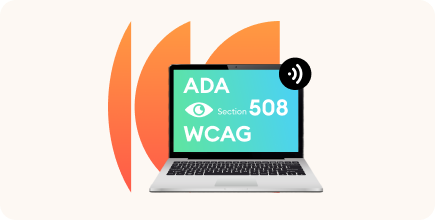eLearning Translation: A Complete Guide for 2026

To achieve your training goals in foreign markets, you need to make quality localization a priority.
This article covers everything you need to know about eLearning translation and localization. We’ll equip you with the right tools and strategies to produce high-quality eLearning content in different languages. With this know-how, you’ll be able to launch learning and corporate training projects in new foreign markets quickly and effectively, maximizing your business ROI.
What Is eLearning Translation?
eLearning translation is the process of converting online training content into another language so it can be delivered to global audiences.
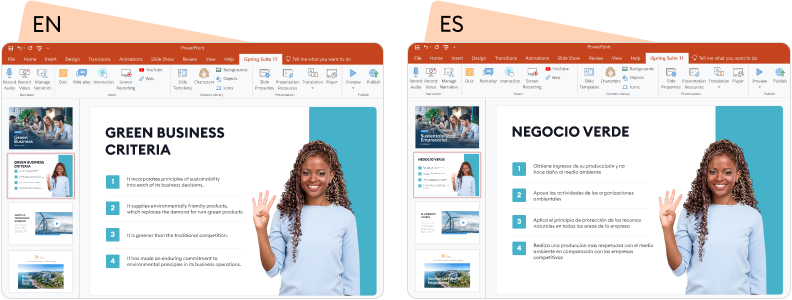
Why Translate eLearning Materials from Your Native Language?
eLearning content translation goes beyond making it understandable for global learners. It’s a smart strategy for growing your business globally.
Translation and localization provide:
- Enhanced learning experiences. Even if learners are proficient in the source language of your eLearning courses, a course in their native language creates a more engaging and relatable learning experience.
- New market opportunities. For businesses, eLearning translation opens new markets and revenue streams by making training content accessible to global audiences.
- Cultural sensitivity. Translation and localization help avoid cultural insensitivity by adapting content to align with cultural norms and values. This is crucial to maintaining a positive image and avoiding misunderstandings in the learning process.
- Inclusivity. By offering eLearning courses and corporate training materials in multiple languages, you ensure that people of various linguistic backgrounds, abilities, and preferences have equal access to knowledge. This approach encourages a stronger sense of community among your learners.
eLearning Translation vs. eLearning Localization
eLearning localization goes beyond mere translation by adapting content to the cultural, regional, and contextual nuances of the target audience. Localization often requires adjusting your eLearning course content to better meet the needs and expectations of learners in a specific region.
“When it comes to creating multilingual eLearning content for the online education market, I’d suggest eLearning localization, not translation. While these two processes may seem the same, they serve different purposes and employ different strategies”.
Here are the main differences between the two approaches:
| eLearning translation | eLearning localization | |
| Goal and focus | Language conversion to ensure that translated courses fully convey the original content | Content adaptation to ensure that localized eLearning courses are culturally relevant |
| Content | Identical to the source material | Can vary depending on the target audience and its cultural context |
| Visual elements | The original visual elements are retained | Visual elements can be changed to align with local preferences |
| Tone and style | Maintains the tone and style of the source content | Adjusts tone, style, and humor to align with the target culture’s specifics |
| Cultural sensitivity | Leaves room for cultural insensitivity | Ensures cultural sensitivity by removing or changing content that can be controversial in the target culture |
| Examples | Technical manuals, instructions, and general knowledge courses | eLearning courses on culture-specific knowledge and skills (communication strategies, workplace ethics, etc.) |
eLearning courses: translate or localize?
Depending on your goals and the type of content in your multilingual courses, you can benefit from eLearning translation and/or eLearning localization.
To decide which approach is better for your specific case, ask the following questions:
- Who is the target audience? Consider the cultural and linguistic diversity of your learners. Will translation be sufficient, or will additional modifications to the content be necessary?
- What is the nature of the content? Evaluate whether your content contains cultural nuances and references, idioms, or examples specific to a particular region or culture.
- What are the budget and timeline? Assess the resources available and the urgency of your project. Localization may require more time and resources than translation.
- Is cultural sensitivity important for the content? Consider the potential impact of cultural insensitivity on your learners and whether adjustments are needed.
- Is the content evergreen, or does it need frequent updates? If your eLearning courses change often, remember that each update will require re-translation or re-localization. A simpler translation process may save time and cost, while localization can require more ongoing effort.
- Do you have access to subject matter experts for the target region? Having experts who understand both the subject matter and the culture can be crucial for effective translation and localization.
Example
Let’s say you have a series of eLearning courses on green business for corporate training in English, and your audience includes employees who speak both English and Japanese. Initially, you consider translating the courses into Japanese. However, upon reviewing the content, you find that it’s US-centric, featuring principles and examples specific to the United States.
To make it more relevant to employees in Japan, you decide to opt for localization. This means not only translating the text but also adapting practices, using regional case studies, and adjusting workplace simulations to match local practices. While this approach requires a slightly longer timeline and a higher budget, it ensures that the translated content is accessible, culturally relevant, and compliant with local safety standards.

eLearning Translation Costs: Key Factors
It can be difficult to plan the budget for your eLearning translation project. Consider the following factors to make a more accurate estimate:
- Content volume. This factor is fairly self-explanatory: the higher the word count, the more expensive the translation will be.
- Time constraints. Both translation vendors and independent translators charge more for rush turnarounds.
- Project management. Multilingual eLearning publishers may need to hire a project manager to launch several translated eLearning courses simultaneously, which can lead to additional costs.
- Quality assurance. Quality checks, rounds of proofreading, and revisions can add to the overall cost of the project.
- Linguistic expertise level. A native speaker-level translator and a professional translation service will typically charge more than a freelance translator. Another option would be to use AI translation tools.
What are the rates for eLearning translation services?
On average, eLearning translation services can cost anywhere from $0.15 to $0.30 per word. However, the rates for eLearning translation services can vary based on the factors we’ve listed above.
Common eLearning Translation Challenges
Translating an eLearning course into the learners’ native language comes with its own challenges. Watch out for these common roadblocks to prevent delays or poor-quality translations.
Linguistic and cultural differences
Linguistic and cultural nuances can bring unexpected difficulties to the translation or localization process. Even professional translators can get confused when dealing with the intricacies of linguistic and cultural variations.
For example, slang, jokes, or subtle cultural references in the source language may not have direct equivalents in the learners’ native language. In such cases, translators can opt for localization or even omit these potentially problematic parts of the content from an eLearning course.
Added and hidden translation costs
Unfortunately, hidden costs can creep into your project at any stage. For instance, complex graphics or bulky multimedia elements might require extra translation efforts.
Additional translation costs can also include legal compliance steps to ensure that your eLearning courses meet all the regulatory requirements in the target locale. Quality assurance and multilingual testing are other sources of added translation expenses. Both require extra resources, time, and expertise to verify that the translated materials meet quality standards and provide an optimal learning experience.
Preserving course design
Translated eLearning content often doesn’t fit well within the original layout or design. This can happen because of different text volume and text orientation (e.g., English vs. Arabic). As a result, an otherwise correctly translated text can ruin the appearance of your entire course.

Solving this issue often requires extra effort from your design team, which can result in project delays and additional costs.
To address all these eLearning translation challenges, you need a reliable eLearning translation protocol. Read on to learn how to build one and translate your eLearning content effectively.
Before You Translate: Choose Your Translation Solution
There are plenty of translation and localization solutions available. You can opt for different translation services:
- AI translation tools. Perfect when speed, scalability, and cost efficiency are priorities, especially for large volumes of text or tight deadlines. However, human post-editing is still necessary to ensure accuracy and cultural appropriateness in eLearning contexts.
- Freelance translators. Best for smaller or occasional projects that require specific expertise (e.g., healthcare, finance, or compliance training) and include culturally sensitive content.
- Translation agency. Best for large-scale, multi-language projects that need consistent quality, project management, and multimedia localization. They handle everything end-to-end but cost more.
- In-house translator. Suitable when you produce several courses each month for a specific language pair.
Pro tip: You can combine AI translation software and a team of translators for more effective eLearning translation and localization. AI translation software will make the translation process faster, and then professional native translators can review the translated content in the target language.
How to Translate an eLearning Course for Multilingual Courses
Most learning management systems and course authoring tools available on the market don’t have a built-in translation tool. However, almost all major eLearning course creation tools include an XLIFF export option.
XLIFF is one of the file formats that simplifies data transfer between different software for streamlined translation. This feature lets you quickly extract your course materials, translate them, and then import the translated content back into the tool.
How to use the XLIFF export feature
To illustrate how to translate courses into different languages, let’s take iSpring Suite, a robust PowerPoint-based authoring tool, as an example. It offers the XLIFF export feature to optimize the translation process. Here is how it works.

1. Click on the Translation tab.
2. Click on Export Text.
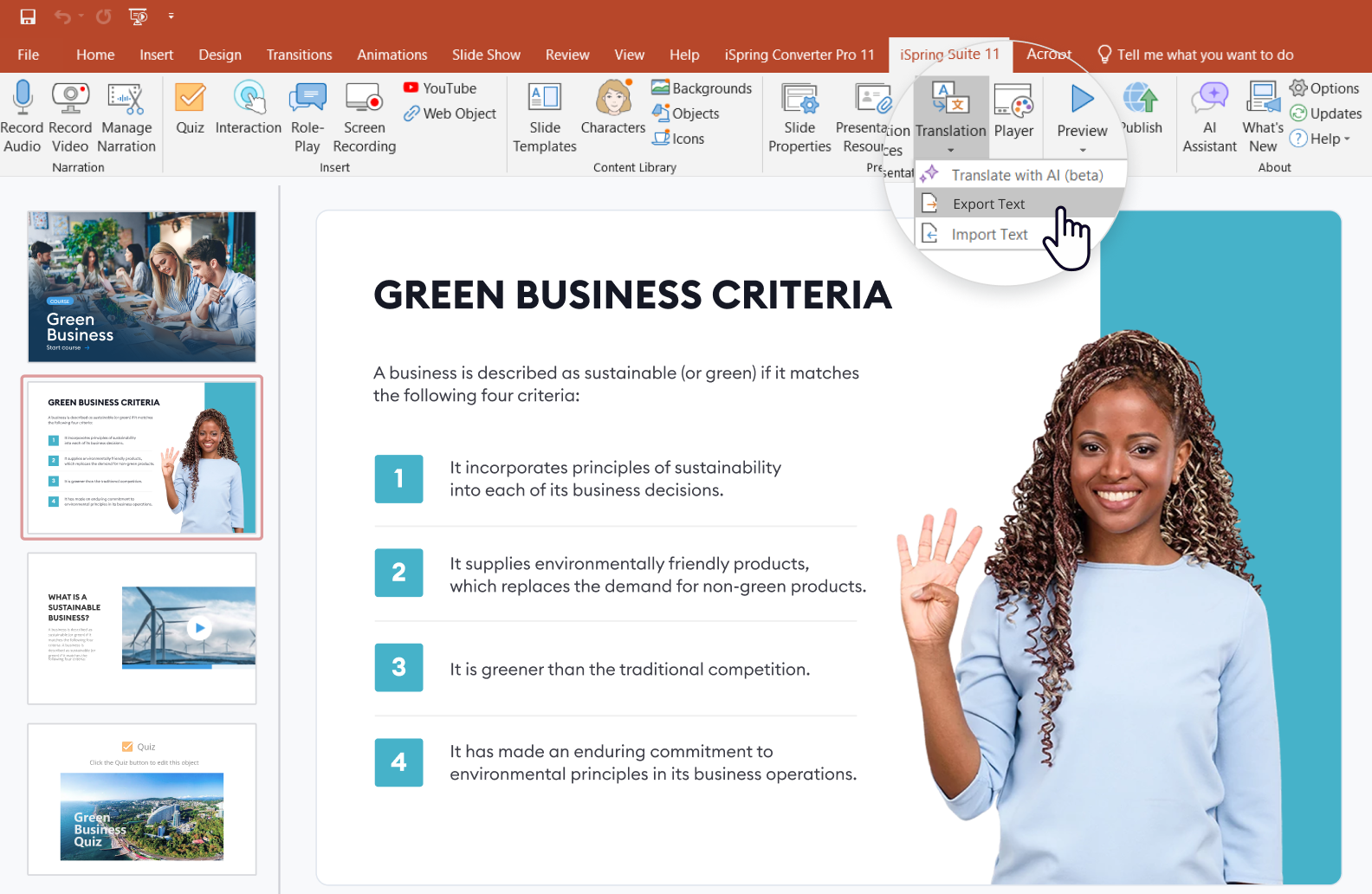
3. Choose XLIFF 1.2 in the list of file formats.
4. Click on Export.
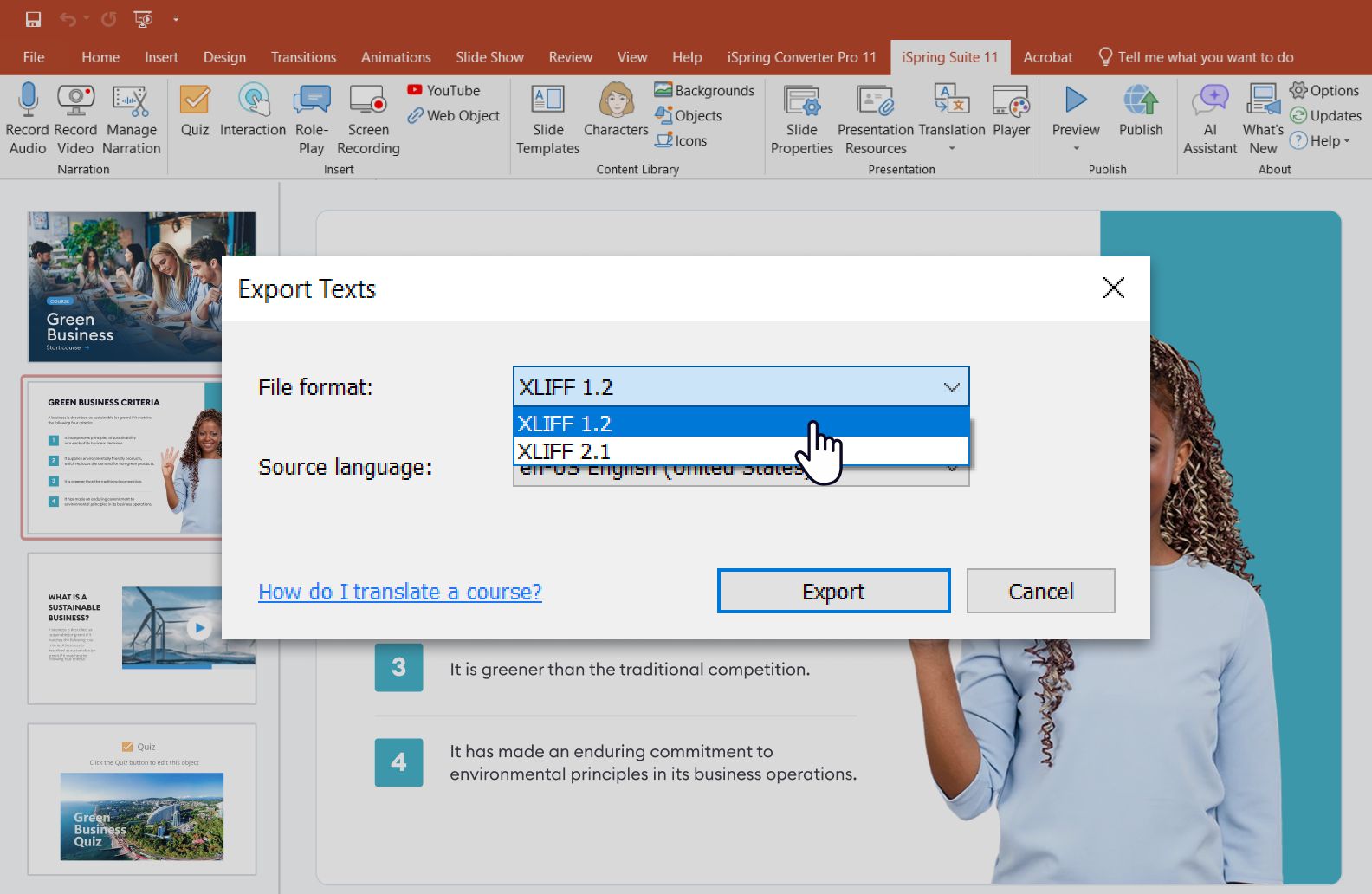
5. Translate your course. You can translate the course with your in-house translation team or outsource the task to a translation vendor. Whichever approach you choose, make sure the translated file is also in the XLIFF format. To see a detailed example of this step, read our article on how to translate eLearning courses and tests with iSpring Suite AI fast.
6. Import the translated content back into iSpring Suite: click on Translation → select Import Text.
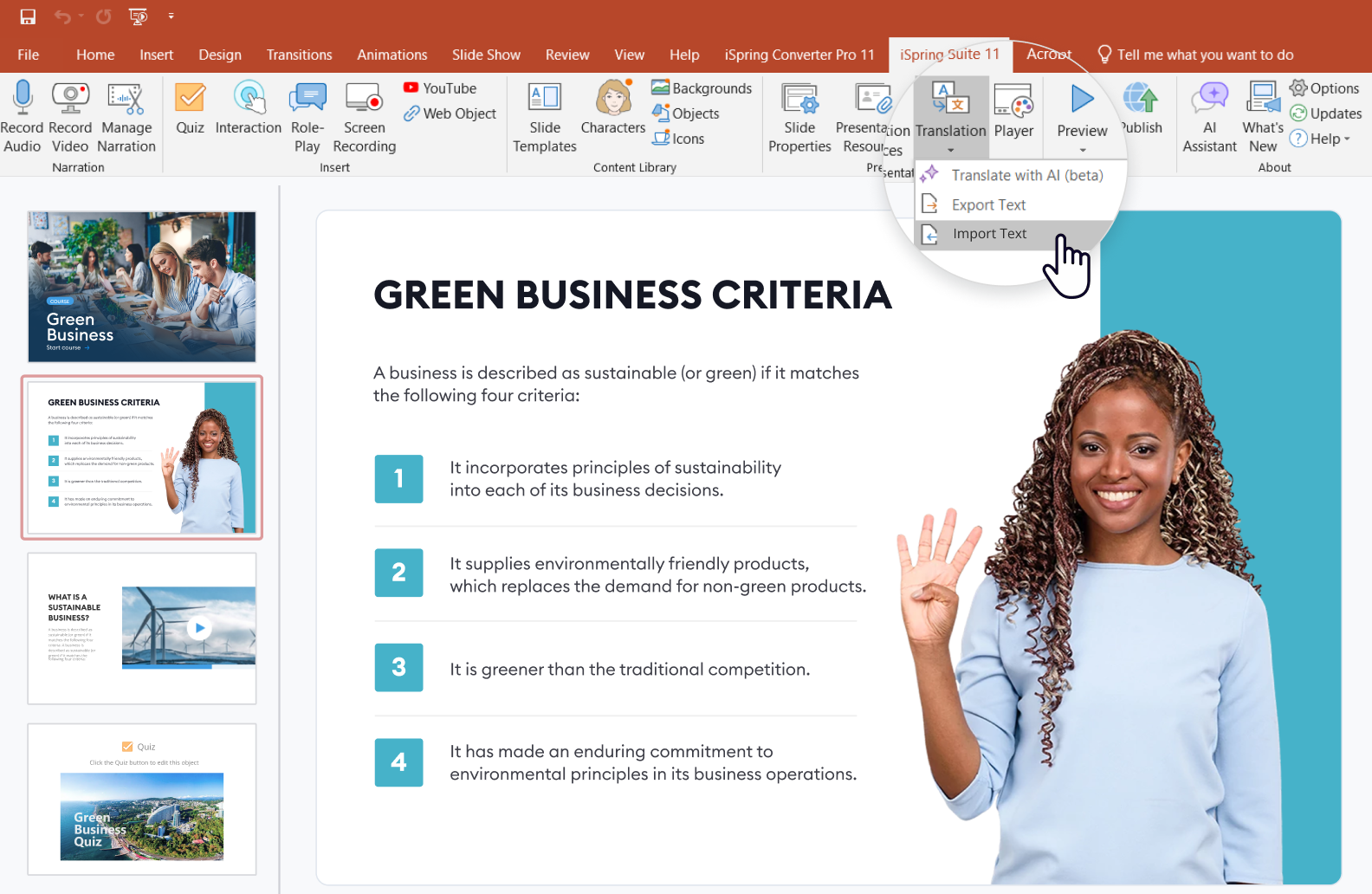
At this point, you’ll get a warning that your current content is going to be replaced with the translated text. If you don’t want to lose the course in the original language, click on Create a copy.
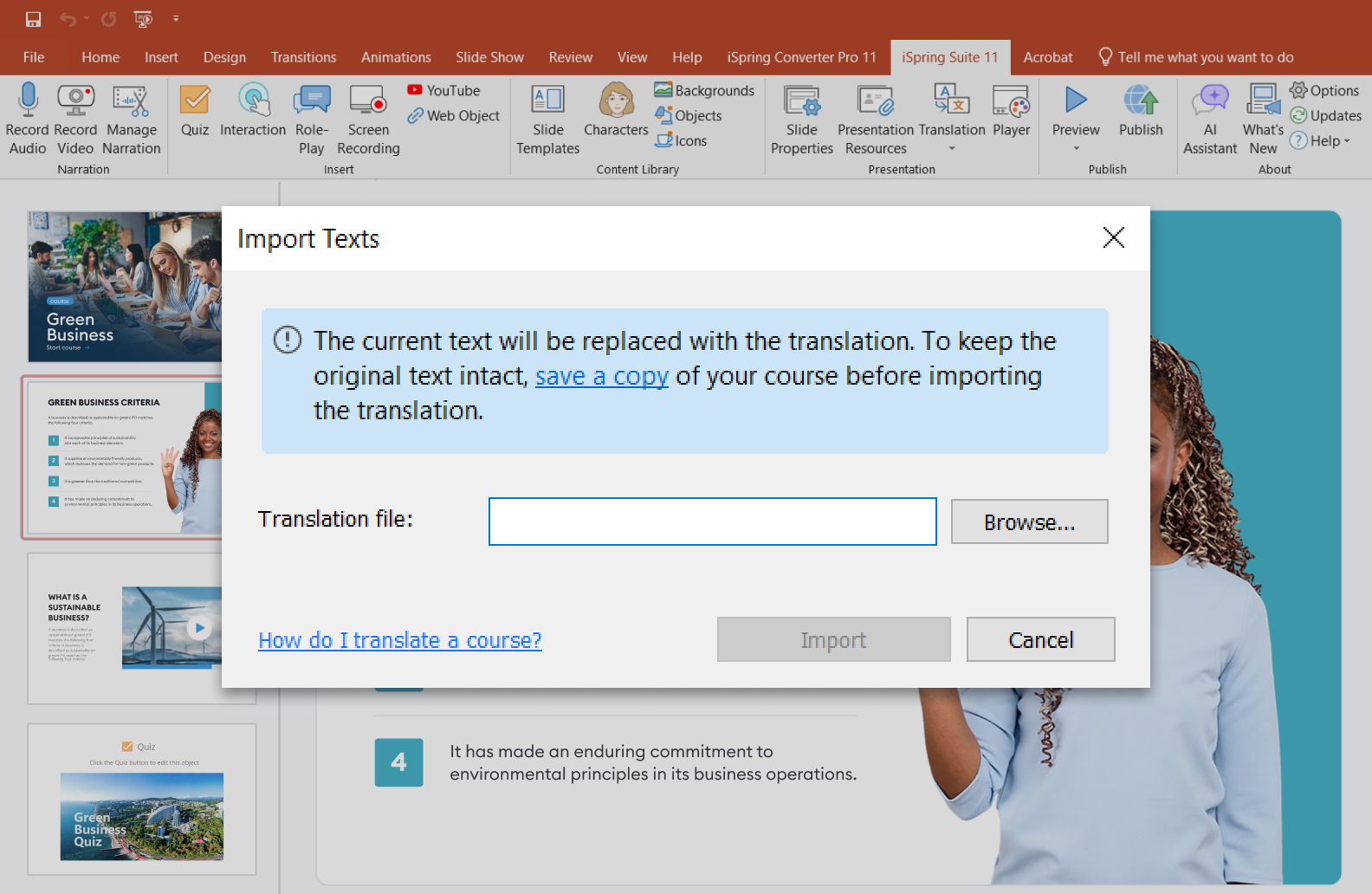
7. Choose the correct XLIFF file from your computer and upload it.
And that’s it! Now you can display the course to your learners in a new language.
Pro tip: If you want to localize your course presentations in iSpring Suite, use the custom character feature to make them more culturally sensitive. You can adapt a character’s appearance to the cultural norms and expectations of your audience for a more organic learning experience.
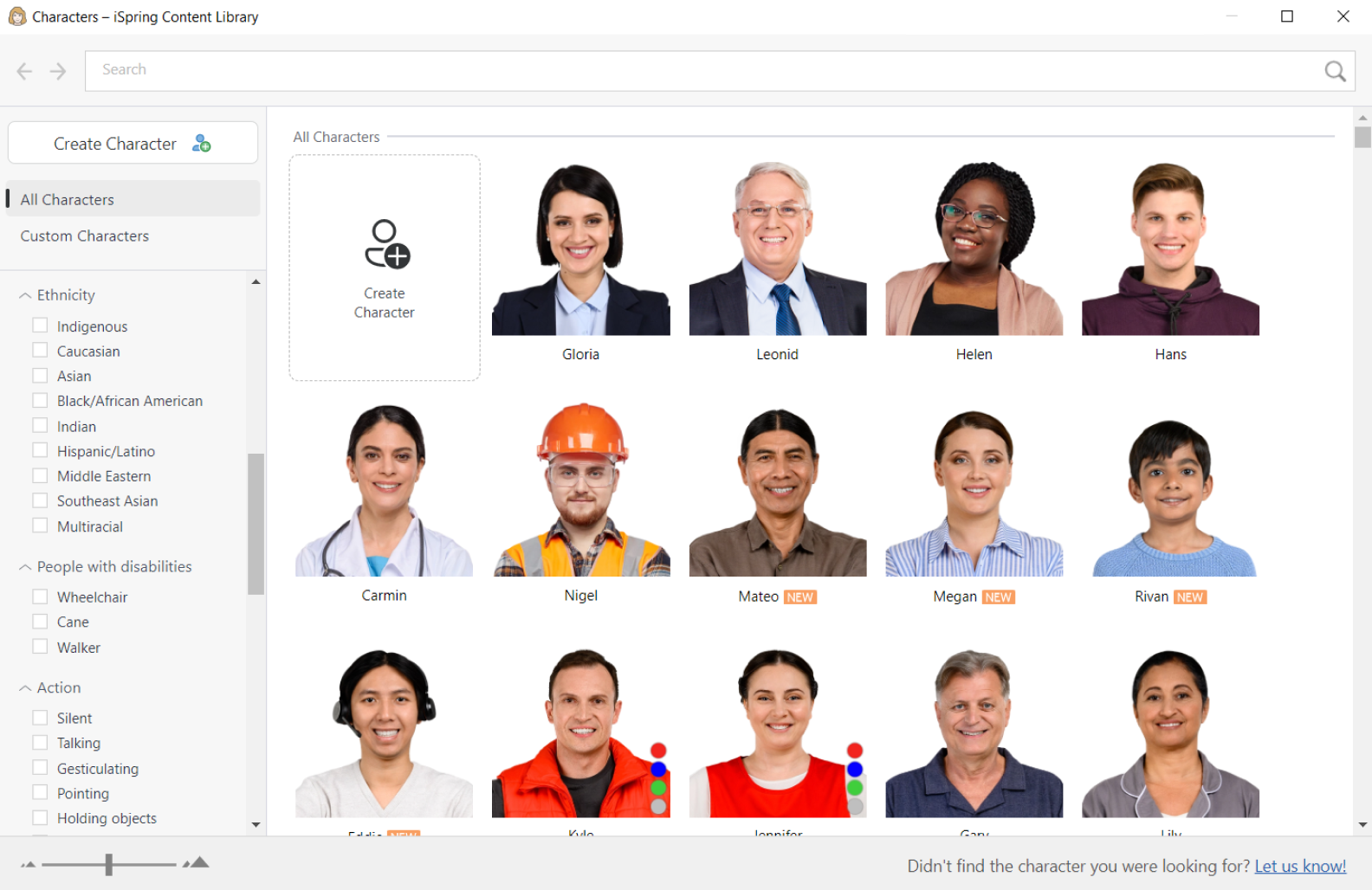
How to automate eLearning course translation with iSpring Suite
With iSpring Suite, you can also translate your course content using AI directly in PowerPoint and then send it for review by human translators.
Here’s how it works:
Open your course and go to the iSpring Suite 11 tab.
- 2. Click on Translation → Translate with AI (beta).

3. Select the target language, and then click on Translate.
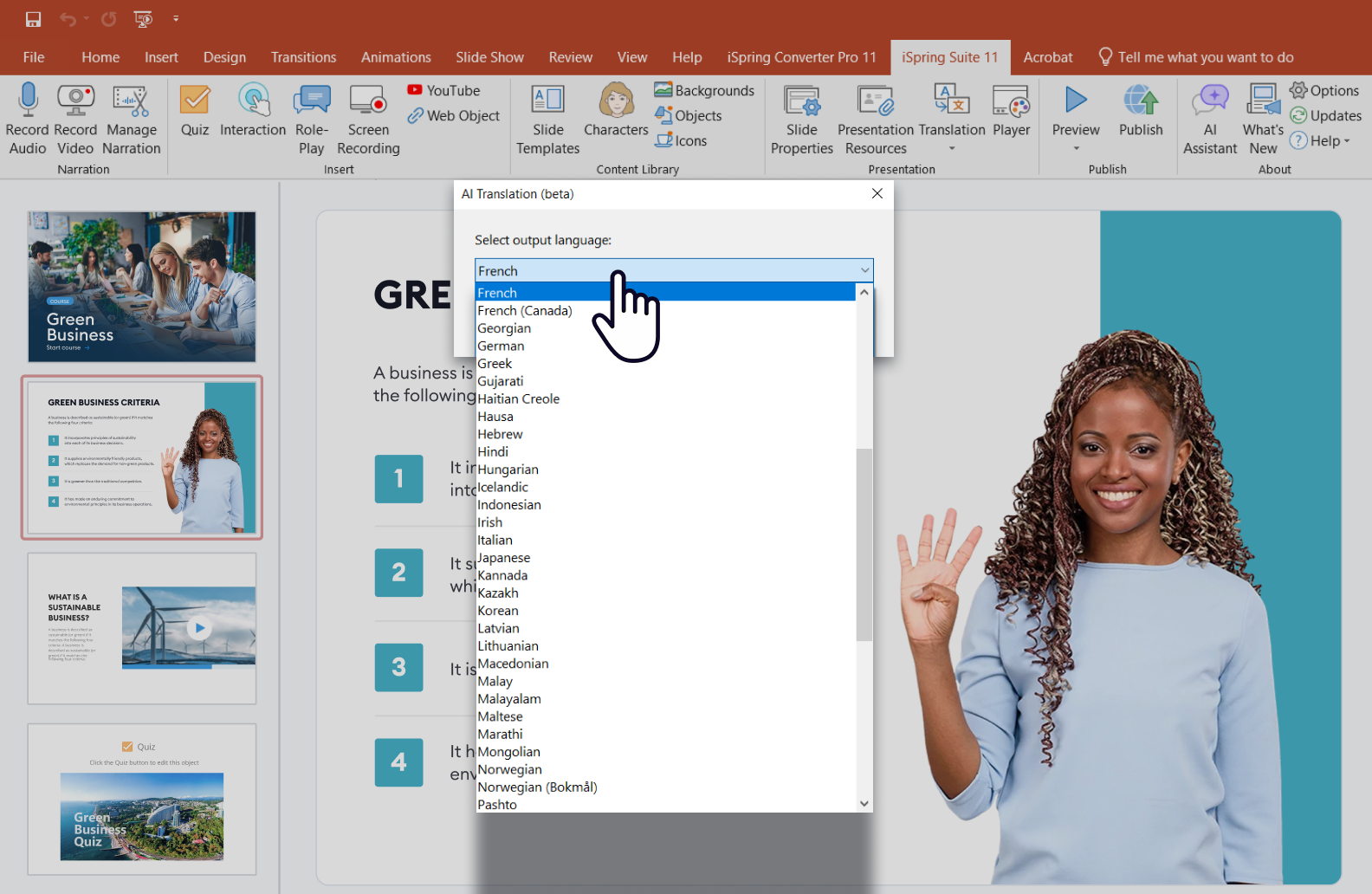
4. A message will appear saying that the original text will be replaced. To preserve it, create a copy of the course before proceeding.
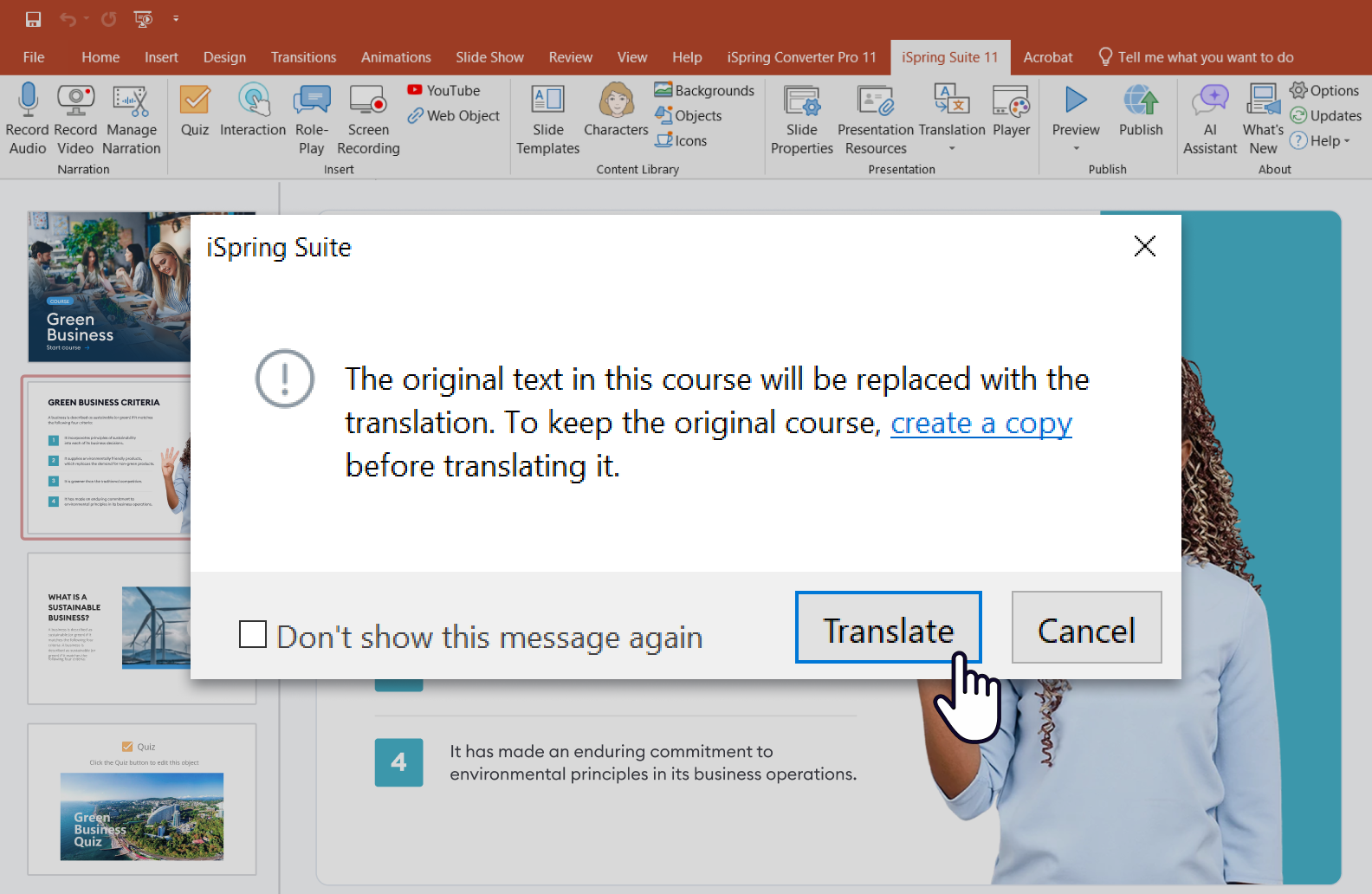
5. Click on Translate again to start.
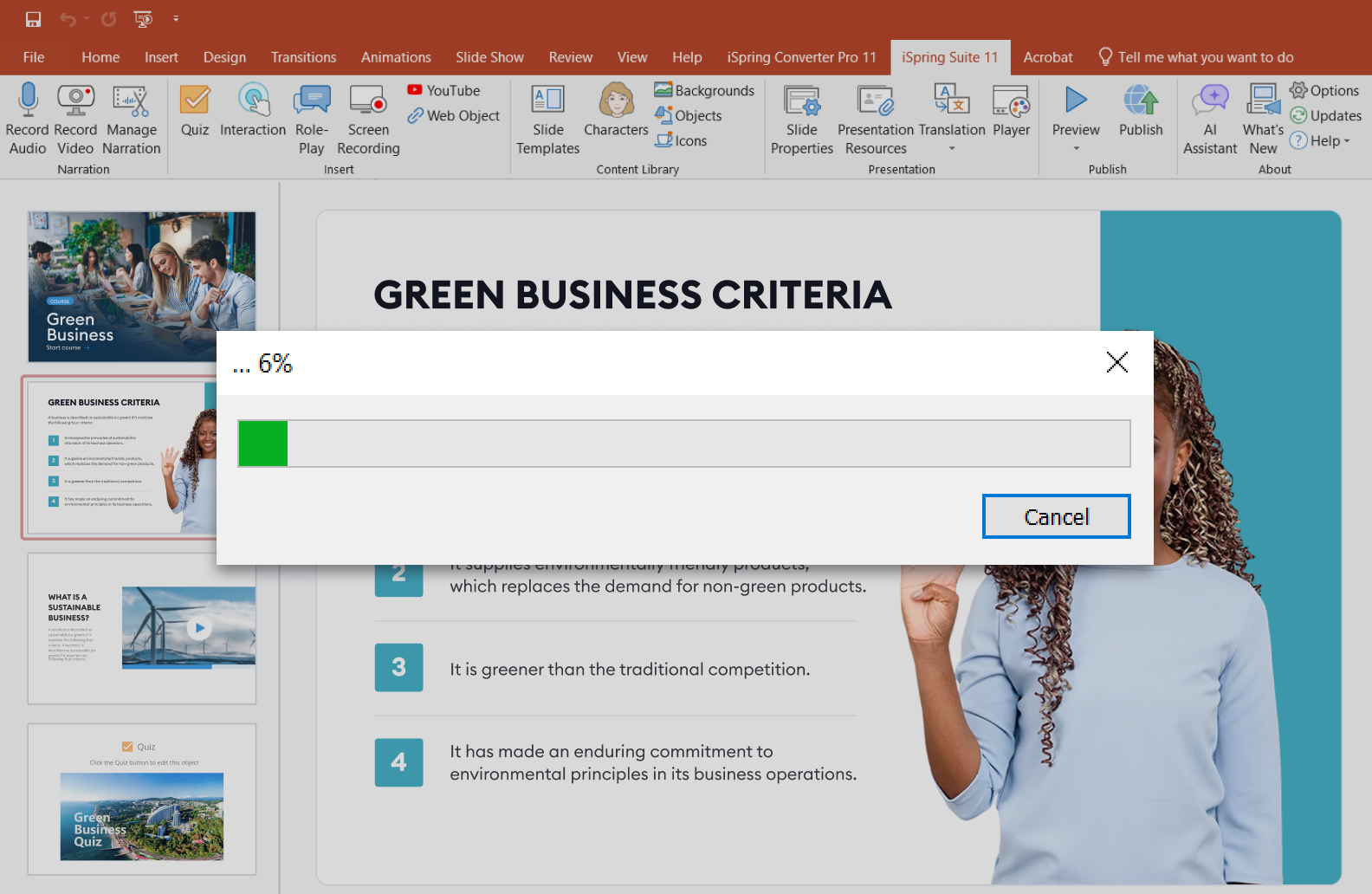
6. When the process completes, review the layout and formatting in the translated version and adjust if needed.
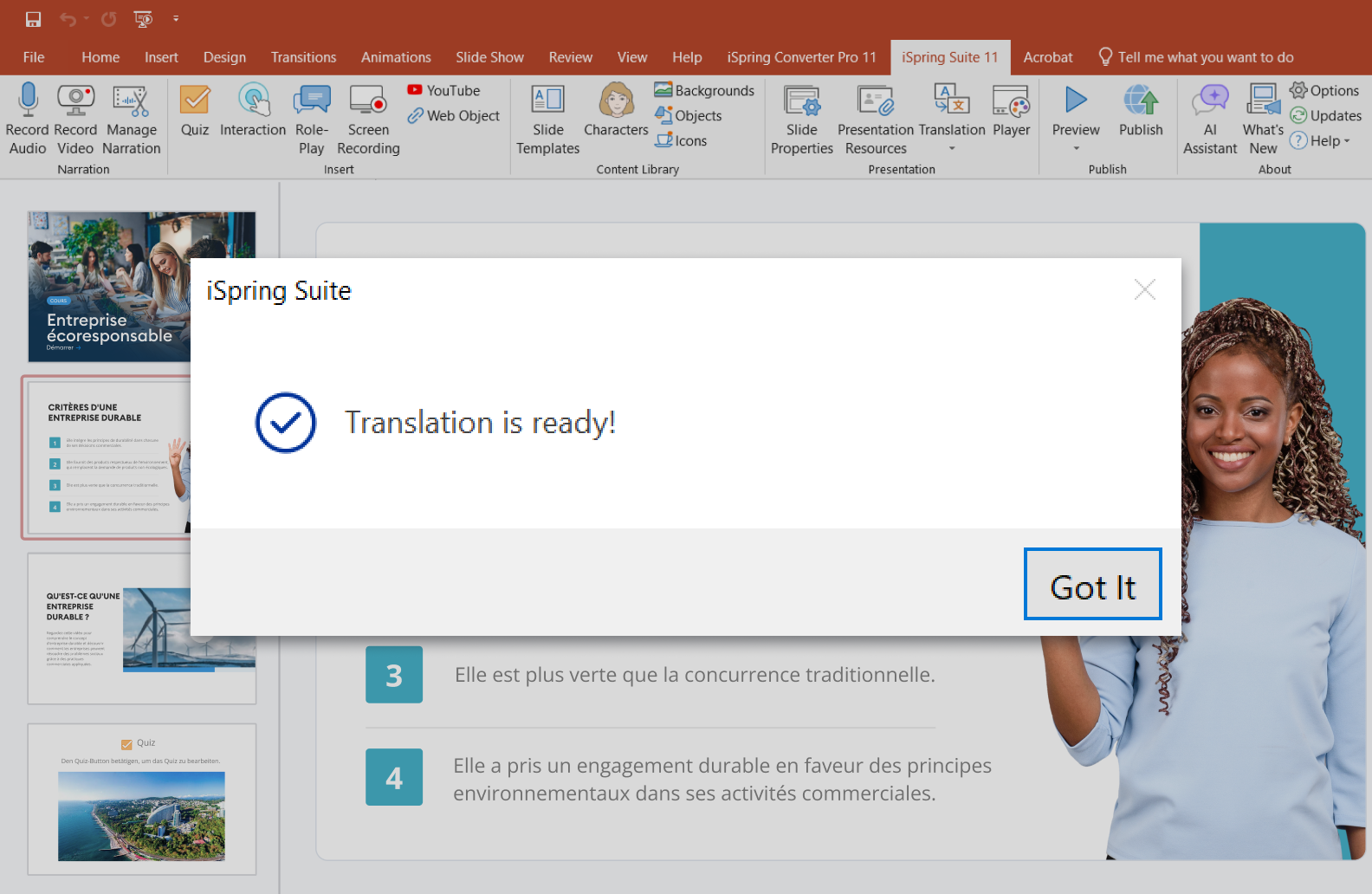
Note: Player elements, text formulas, quizzes, interactions, role-plays, and other content items created with iSpring Suite sub-tools need to be translated manually.
7. To generate voice-overs, you can use the Text-to-Speech (TTS) feature. You just need to add text to iSpring Suite AI, select a language, and a preferred voice. The tool enables changing intonation, adding pauses, and adjusting pronunciation so the voice sounds beautiful and confident.
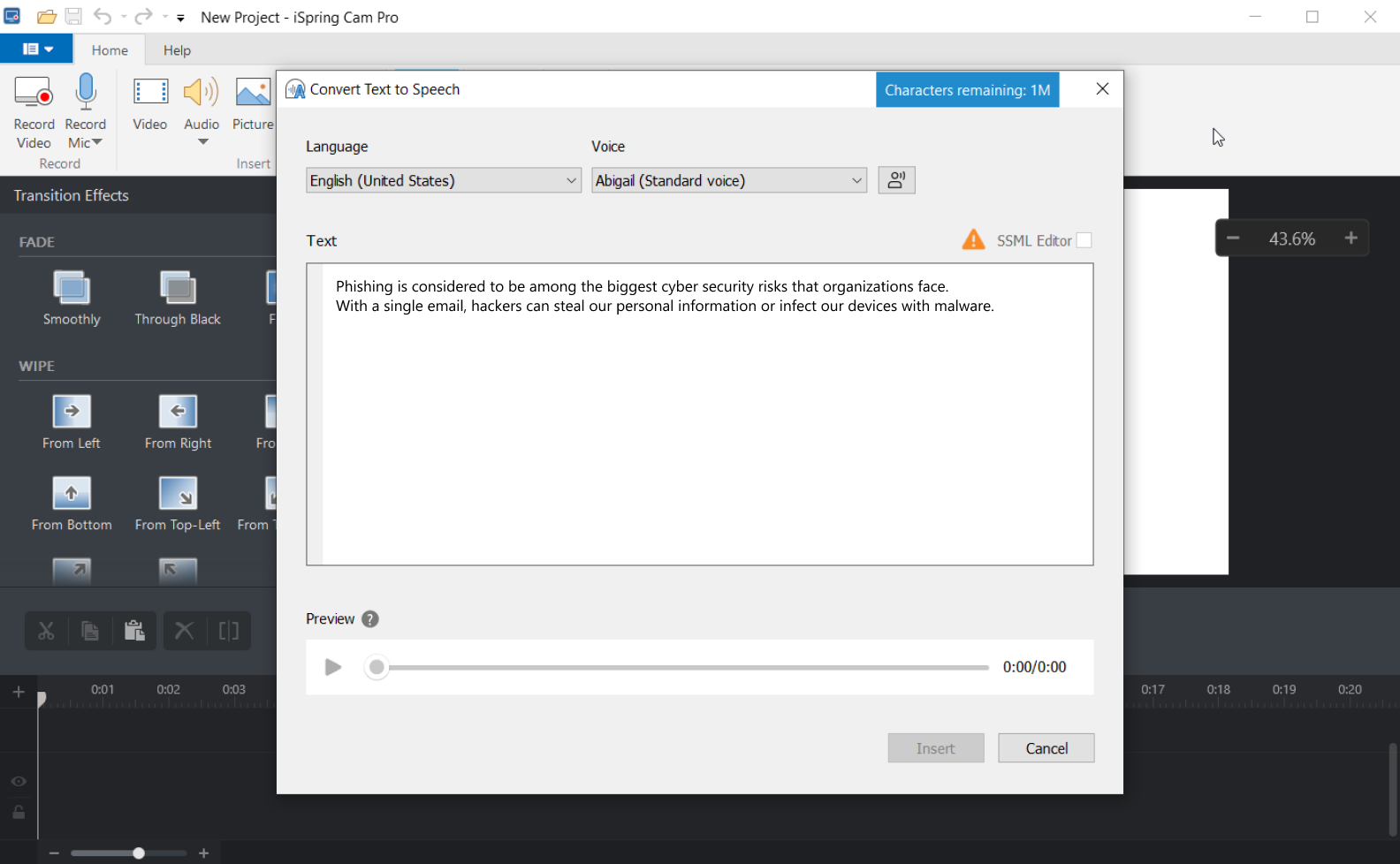
Best Practices for a Great eLearning Translation Project
Regardless of your eLearning translation needs, you can follow a few simple tips to improve the translation process and avoid possible challenges.
Expect text expansion in the target language
One thing many people overlook during translation is that content in one language can take up more space than it does in a different language. For example, two eLearning courses with the same content will look different on a slide or in authoring tools.

As a result, the appearance of your eLearning content can go awry. To avoid this problem, prepare your course layout for text expansion in advance. You can leave some extra space on your slides or choose a smaller font to present content on your eLearning platform.
Make your original eLearning courses translation-friendly
Another thing you can do to ensure a seamless transition process is to create your original course and other reference materials with a multilingual perspective in mind.
To build a translation-friendly course, you can:
- Avoid cultural references, slang, or jokes in your content. These elements can be difficult to translate without changing the original meaning. They can also be offensive in the recipient culture.
- Create a glossary of special terms to help translators choose the right translations in complex cases. Pick the technical terms, brand names, acronyms, etc., in your source language. Write a short definition, usage context, and examples, so translators understand what you mean.
- Use variables instead of hard-coded text. Avoid animations or images with embedded text. Instead, use regular text strings in your eLearning development tool. This will allow you to translate the strings as part of an exported XLIFF file, and you won’t need to replace all the images or animations in a translated course.
Remember to translate multimedia elements
When you export your course as an XLIFF file, it will only contain text. This means you’ll need to translate other eLearning assets separately. These include:
- Images and videos
- Closed captions
- Handouts
- Audio narration
Pro tip: Translating audio narrations is easier and more convenient if the eLearning tool has a text-to-speech feature (TTS). That way, you can just type the translated narration into the TTS box and get high-quality audio with a human-sounding voice.
As previously mentioned, iSpring Suite AI offers a text-to-speech feature in 58 different languages with authentic voices and natural intonations. You won’t need to hire voice actors for your localization projects, thus saving tons of time and money, while still engaging your audience with effective narrations.
FAQ on eLearning Translations and Localization
Here are some popular questions our readers ask about the process of translating eLearning course content.
How do I choose the right translation vendor?
You have plenty of options, ranging from a translation company or freelance translators to one of the available translation management systems. When choosing your vendor, consider:
- A project’s budget
- Complexity of the content
- The number of language pairs you’ll need to translate
- The potential need to hire SMEs in a target language
- In-house translation capacity
Choose the vendor that can cater to your specific project needs within the set timeline and budget for the best eLearning translation experience.
How can I assess the ROI of eLearning translation projects?
Measuring the ROI of eLearning translation projects involves evaluating both the costs and benefits. Start by calculating the expenses, including translation, localization, design and formatting adjustments, tools, project management, quality assurance, and compliance and legal checks.
Then, assess the impact on your target audience, such as increased engagement, learner retention, or expanded market reach. Did the translation affect your business goals positively? Don’t forget to consider long-term benefits, such as ongoing content usage and market expansion, to get a comprehensive view of the project’s return on investment.
Also read: How to Measure eLearning ROI
How can I ensure privacy and data security during translation?
To ensure privacy and data security during translation, you can take the following steps:
- Sign NDAs with translators and teams to protect sensitive information.
- Use encrypted channels to share content and maintain communication with stakeholders.
- Restrict access to project files and sensitive data to essential team members only.
- Remove or anonymize sensitive information when possible, reducing privacy risks.
Final Thoughts
Incorporating eLearning translation into your educational or corporate strategy broadens your reach and cultivates a more inclusive and globally connected learning environment. By breaking language barriers, you open the door to global audiences, boosting engagement and knowledge retention.
Consider making eLearning translation an integral part of your projects for a more effective and globally resonant learning experience. In case your authoring tool doesn’t offer an XLIFF export feature for streamlined translation, try iSpring Suite for free.


